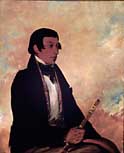

The Calumet dance, which is very famous among these peoples, is performed solely for important reasons. . . . Those who have been appointed to sing take the most honorable place under the [tree] branches; these are the men and women who are gifted with the best voices, and who sing together in perfect harmony. (Jacques Marquette, 1674)![]()
Music was part of the social, political, and religious lives of the Illinois people. It played an important role in the calumet dance, a ceremony for which the Illinois were justly famous. At the beginning of the dance, male and female singers would stand in a place of honor and sing songs to accompany a series of dancers as each took his turn dancing with the calumet pipe. During the second part of the dance, accompanied by the sound of a drum, the singers continued to sing songs as the head dancer and a warrior performed a mock battle between the calumet and weapons of war.
Jacques Marquette wrote out the words and musical notation of a song that was part of a calumet dance performed in his honor by the Peoria tribe in 1673. The song has a beautiful melody, a wide dynamic range, and what appears to be a slow, chant-like rhythm.
 |
Kee-mon-saw or Little Chief, a Kaskaskia chief, holding a wooden flute. (watercolor by George Catlin, 1830) enlarge |
The Illinois played at least three musical instruments: drum, rattle, and flute. The drum was a large ceramic pot, half filled with water, in which the opening was covered with a drum-head made of buckskin. Drums were played during calumet dances and also to signal the departure of war parties marching off to battle. The rattle, called a chichicoya, was made of a hollow gourd that contained glass beads and was attached to a wooden handle. It was played by shamans during healing rituals. The flute was an end-blown instrument, evidently made of wood, which resembled a European recorder or flageolet.![]()
|
|
Copyright © 2000 Illinois State Museum